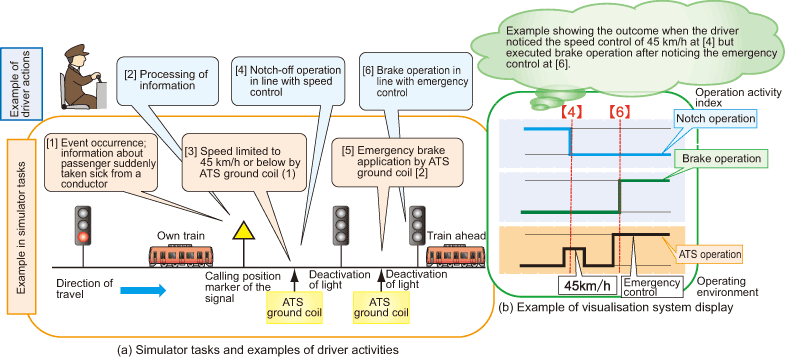5. Training program to develop drivers' ability to respond to problems
- The RTRI developed an educational training program to improve drivers’ ability to respond to problems and/or abnormal situations.
- It also developed a system of visualising results in order to enhance the effects of raising awareness as a form of education.
When an accident occurs, drivers may fail to take action that they would usually be capable of as a result of anxiety and/or shock if the cause cannot be identified or the accident stems from driver error, etc. This may cause secondary errors due to relief or loss of concentration when normal operation is resumed.
Accordingly, RTRI devised simulator tasks in which events induced by errors were incorporated in order to artificially reproduce the psychological shocks on a train operation simulator. Figure 1 (a) shows an example of such a task based on a simulated section of actual track on a given railway network. In this scenario, the driver experiences the stress of causing a SPAD by going through a deactivated signal as he/she is informed of a passenger suddenly being taken sick by the conductor, at precisely the moment they were supposed to check the signal (1) during running.
Two block signals are in a deactivated state, and there is a train ahead. Accordingly, since the deactivation of the signal (1) mechanically generates a warning signal, speed is limited to 45 km/h or below by means of an ATS ground coil (1). A total of 15 drivers out of 18 stopped the train after passing the deactivated signal (1), while one driver even failed to notice both successive deactivated signals (1) and (2).
An important factor in enhancing drivers’ ability to respond to problems is to make them experience their own errors during simulation. It is possible to have drivers correctly understand and recognise their own failures by incorporating a visualisation system (Fig. 1 (b)) that shows the relation between an index of operational activities such as the powering notch position, brake handle, etc. and an index of operational environment conditions such as ATS operating information.
 Fig. 1 Example of a task involving block signal deactivation
Fig. 1 Example of a task involving block signal deactivation